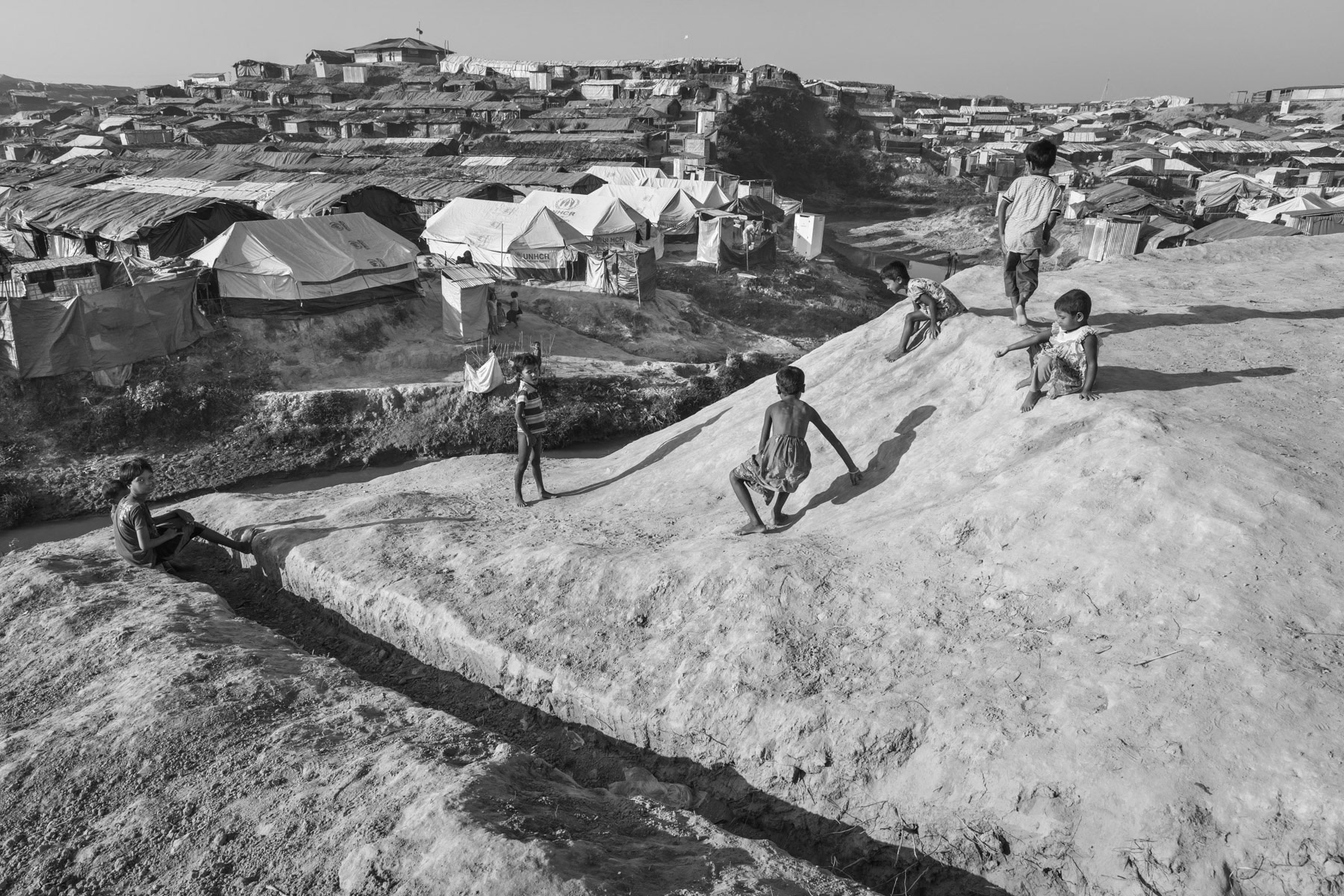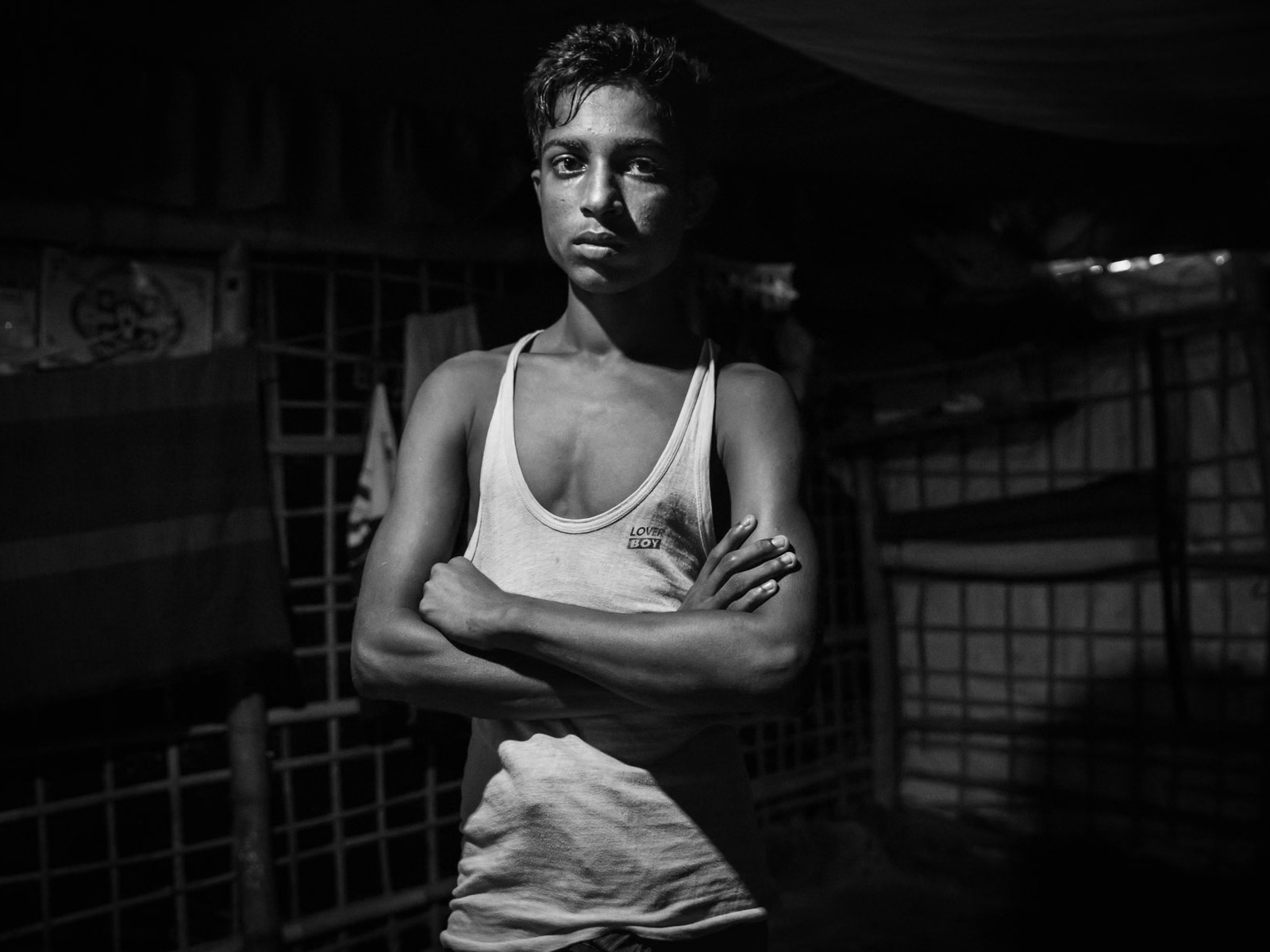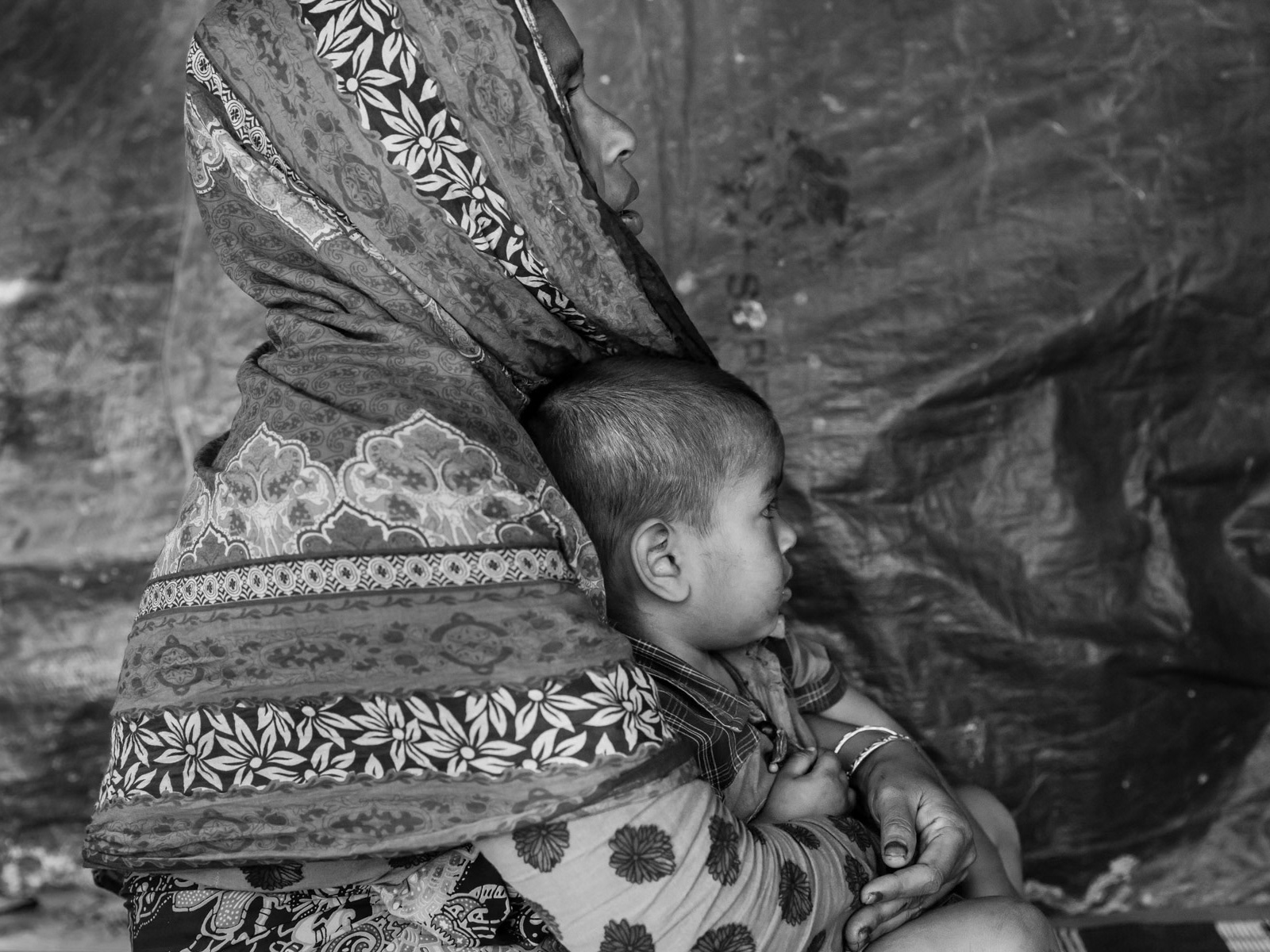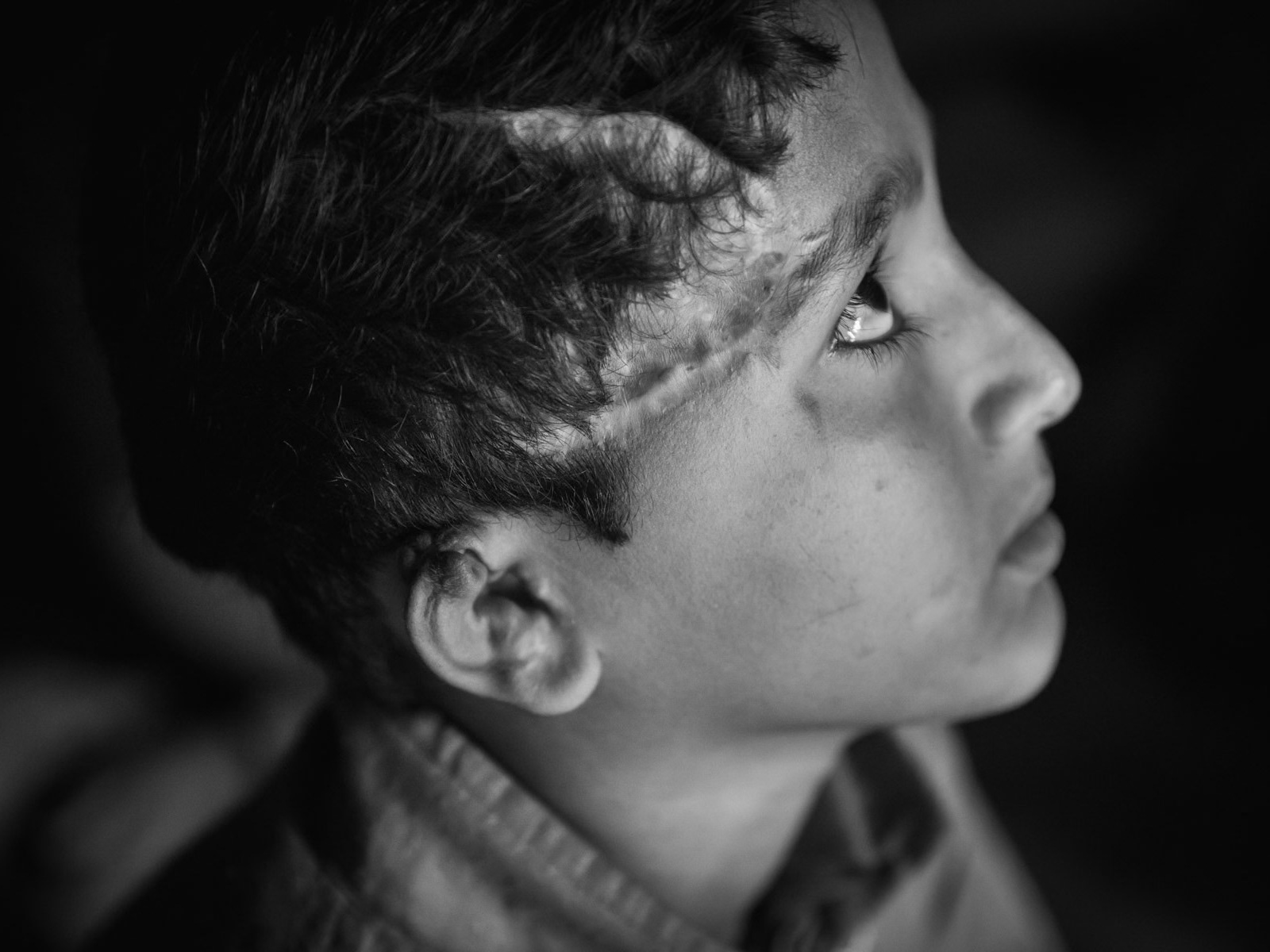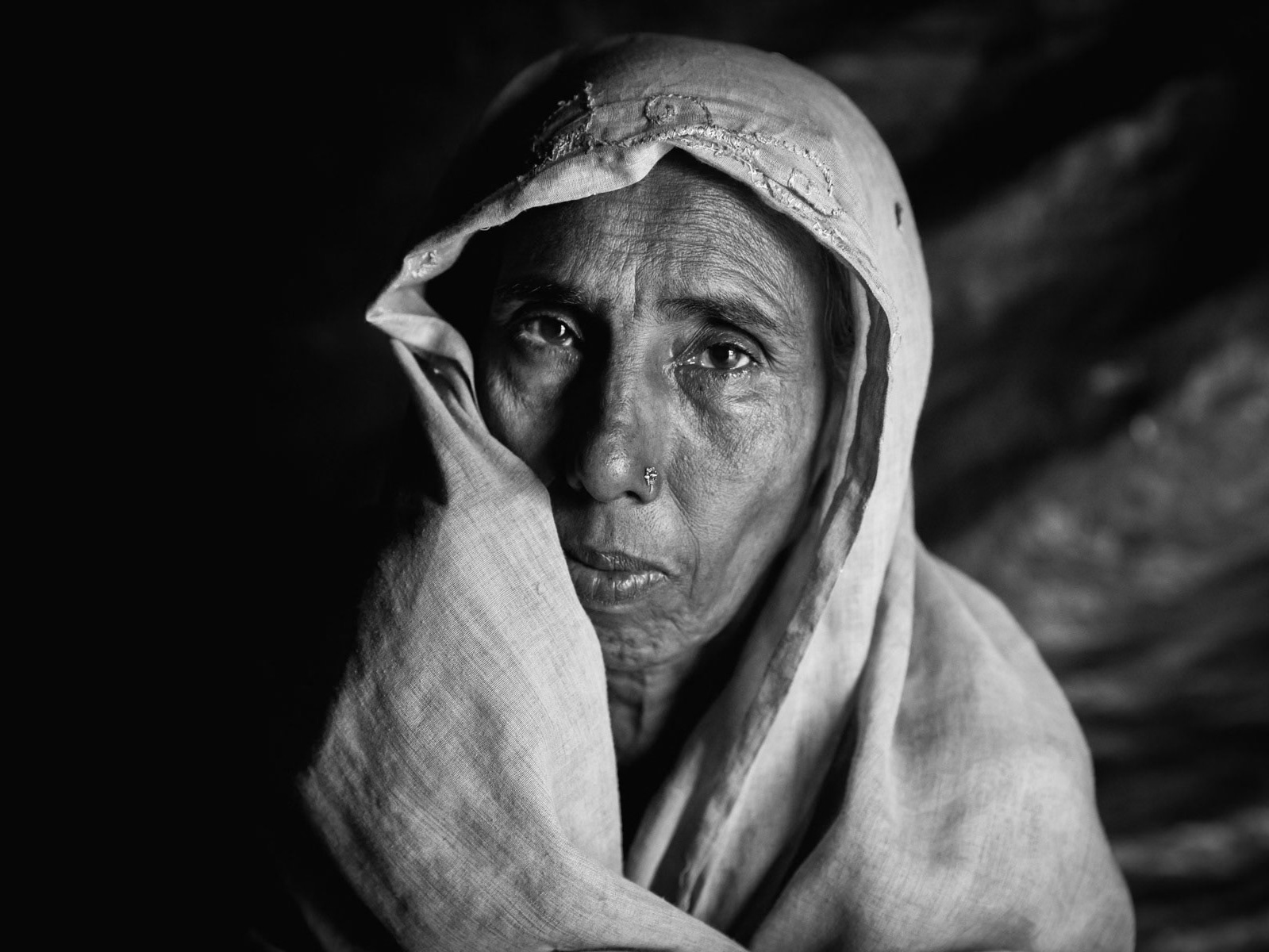Between 2016 and 2017, the Rohingya, a Muslim minority group in Myanmar's Rakhine State, were subjected to waves of horrific persecution and violence, which many international observers and human rights organizations have described as ethnic cleansing. In a brutal crackdown following attacks on security posts by Rohingya militants, the Myanmar military launched a series of operations specifically targeting Rohingya civilians. The scale and nature of these atrocities, particularly the systematic nature of the violence, have led some experts and international bodies to allege that these acts may amount to genocide.
The military’s operations were carried out with unprecedented brutality, involving widespread killings, torture, and sexual violence against innocent civilians. Rohingya men, women, and children were systematically targeted and subjected to violence, often in an indiscriminate and cruel manner. The violence was not limited to individual acts of aggression but included the deliberate destruction of entire villages, many of which were set ablaze, leaving families displaced and destitute. This large-scale destruction and forced displacement of an entire ethnic group align with many of the signs of genocide as outlined in the United Nations Genocide Convention, particularly the intent to destroy, in whole or in part, a national, ethnical, racial, or religious group.
Women and girls, in particular, were subjected to egregious forms of sexual violence. There were widespread reports of abductions, gang rapes, and mutilations carried out by soldiers, who used sexual violence as a weapon of war. Survivors of these brutal assaults were left physically and psychologically scarred, many of them impregnated as a result of the violence. The targeting of women in such a systematic manner has been described by human rights groups as an effort to destroy the community’s future generations and further destabilize the group’s cultural and social structure—hallmarks of genocidal acts. Furthermore, reports of babies being thrown into burning buildings or killed in the course of military operations, as well as the widespread killing of men, suggested that the military’s actions were aimed at eliminating the ability of the Rohingya to sustain themselves as a group.
The violence also had devastating consequences for Rohingya children, who were among the most vulnerable. Many children witnessed or experienced extreme violence at a young age, and some were separated from their families, leading to further trauma. Entire generations were deprived of their childhoods, subjected to experiences of violence and loss that are difficult to recover from. The psychological toll on these children has been devastating, and many survivors are left with lasting emotional scars that could affect them for the rest of their lives.
The brutality of the Myanmar military's actions was so widespread that the United Nations and other international bodies have warned that these events show clear signs of genocide. In 2019, the International Court of Justice (ICJ) ruled that Myanmar must take steps to prevent genocide against the Rohingya people and preserve evidence of these crimes, acknowledging the severity of the allegations. The ruling followed months of investigation and testimony, including the documentation of widespread atrocities such as mass killings, forced displacement, and rape. While the ICJ’s decision was a significant step, it also highlighted the challenge of holding Myanmar’s government accountable, especially given the military’s entrenched power and the lack of political will to prosecute the perpetrators.
After fleeing Myanmar, hundreds of thousands of Rohingya refugees crossed into neighboring Bangladesh. They arrived in a state of shock, many suffering from physical injuries, dehydration, and malnutrition. The largest refugee camp in the world, located in Cox’s Bazar, rapidly expanded to accommodate the influx of displaced people. Despite the best efforts of humanitarian organizations, the overcrowded camp lacked adequate sanitation and medical supplies, leading to further health crises. The living conditions were dire, with refugees often facing a daily struggle for basic necessities, including food, clean water, and shelter. These conditions have contributed to the ongoing suffering of the Rohingya people, leaving them in a constant state of uncertainty and despair.
In addition to physical deprivation, the Rohingya refugees face the psychological aftermath of the violence they endured. Many live with the trauma of losing family members, witnessing the destruction of their villages, and experiencing physical and sexual violence. The psychological toll of their experiences has left many survivors emotionally scarred, struggling to rebuild their lives in exile. As the years have passed, the prospects of repatriation have remained uncertain, and the Rohingya continue to face a future filled with displacement, marginalization, and fear. The international community’s inability to effectively address the root causes of the persecution has further compounded the crisis, and the Rohingya remain one of the most vulnerable and displaced populations in the world today.
The legacy of the violence, which included actions consistent with the signs of genocide, continues to affect the Rohingya people. While many international bodies have condemned Myanmar’s actions, the lack of concrete action to hold the perpetrators accountable means that justice for the victims remains elusive. The Rohingya's plight highlights the broader failure of the international community to prevent genocide, protect vulnerable populations, and ensure that those responsible for such heinous acts are held to account.

Rashida B., 25 years old, from Tula Toli near Maungdaw in Burma. Her two children were killed by the military forces. The house with her dead children was burned down. She was taken away with 30 other women from the village and were gang raped for several hours by military and local militia. After being raped she was assaulted with a machette to her neck and skull and left for dead. When the place was set on fire she escaped through the back and fled. It took her 8 days to reach Bangladesh and receive the first medical care. She lives now in Bangladesh where she was reunited with her sister who was also sexually assaulted. Balukhali Camp, Bangladesh, November 2017.
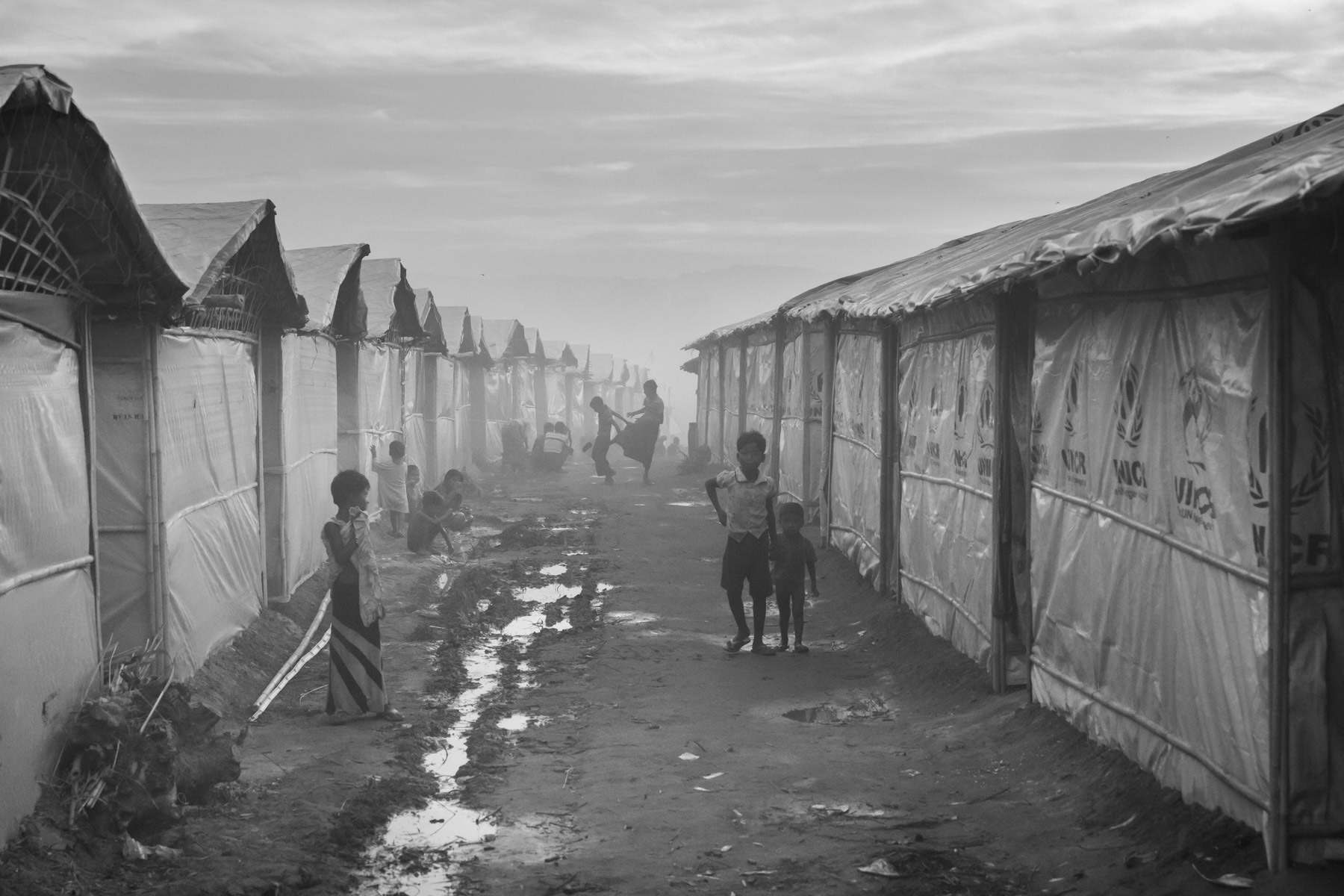
New makeshift blocks for the newly arrived Rohingya refugees from Myanmar. More than 650,000 refugees have fled persecution in neighbouring Myanmar since August 2017. Lambashiya section of Kutupalong refugee camp, Ukhiya, Bangladesh, November 2017

Azida Bibi, 6 years old Rohingya refugee from Sanifara near Maungdaw in Myanmar. She was snatched in her village on 1 September 2017 by Burmese military and forced to drink battery acid. Ever since she has lost more than half her weight as she can't digest any food and is vomitting constantly. She fled immediately after the attack to Bangladesh where she is being treated in a clinic. An estimated 650,000 Rohingya have fled persecution since August 2017 and a widespread security operation carried out by the Myanmar military. Human Rights groups and the UN have called those operations ethnic cleansing campaigns evolving into genocide. Balukhali refugee camp, Cox's Bazar, Bangladesh, November 2017

Rohingya teenager Mohamed Rashid from Maungdaw township in Burma. Before fleeing to Bangladesh he was forced to work for the Myanmar military and was mutilated with a knife by them. His brother and father were killed by the military. Lambashiya camp section, Kutupalong, Bangladesh, November 2017
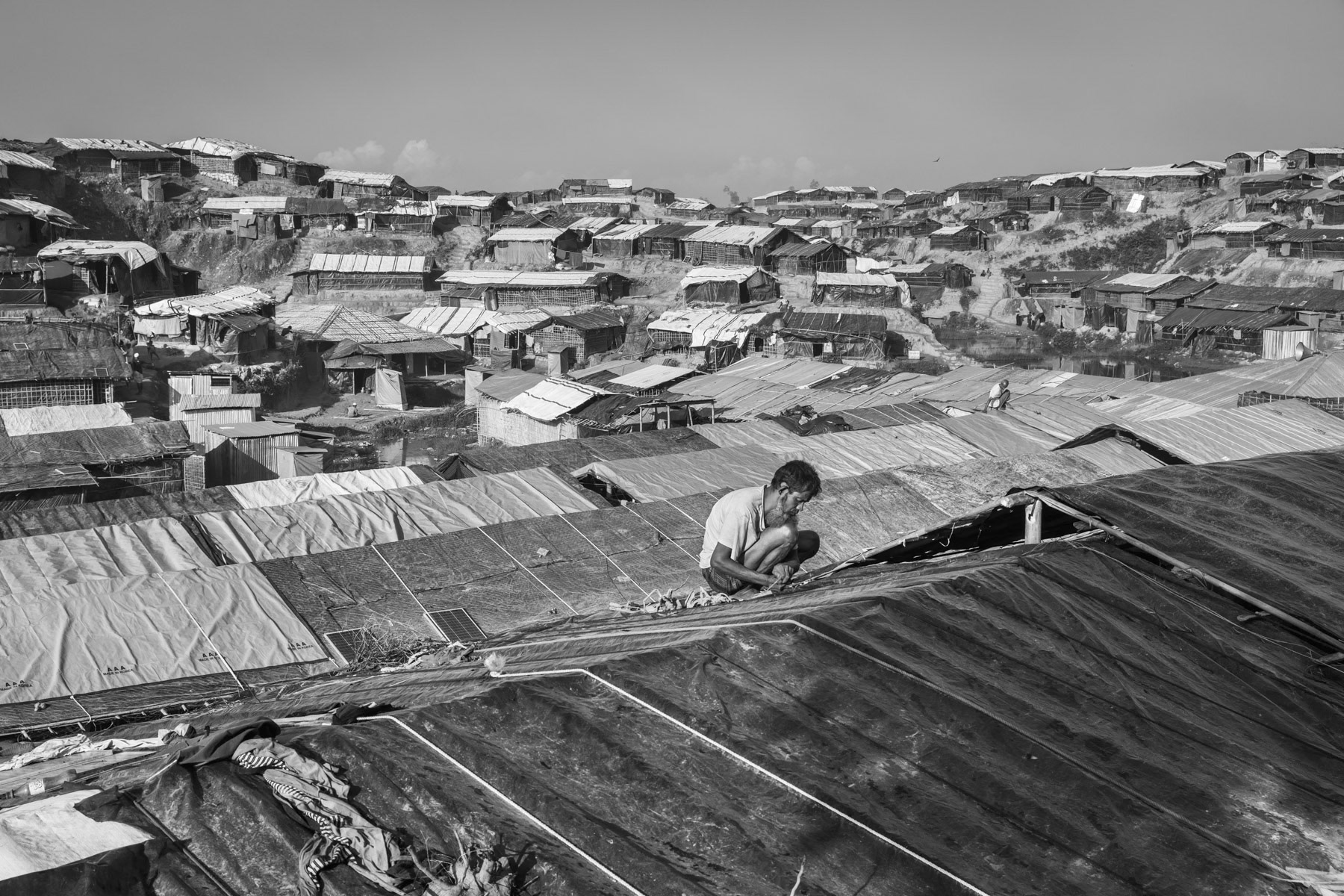
Fixing the roofing at new makeshift blocks for newly arrived Rohingya refugees from Myanmar. More than 650,000 refugees have fled persecution and brutal ethnic cleansing in neighbouring Myanmar since August 2017. Balukhali refugee camp, Ukhiya, Bangladesh, November 2017
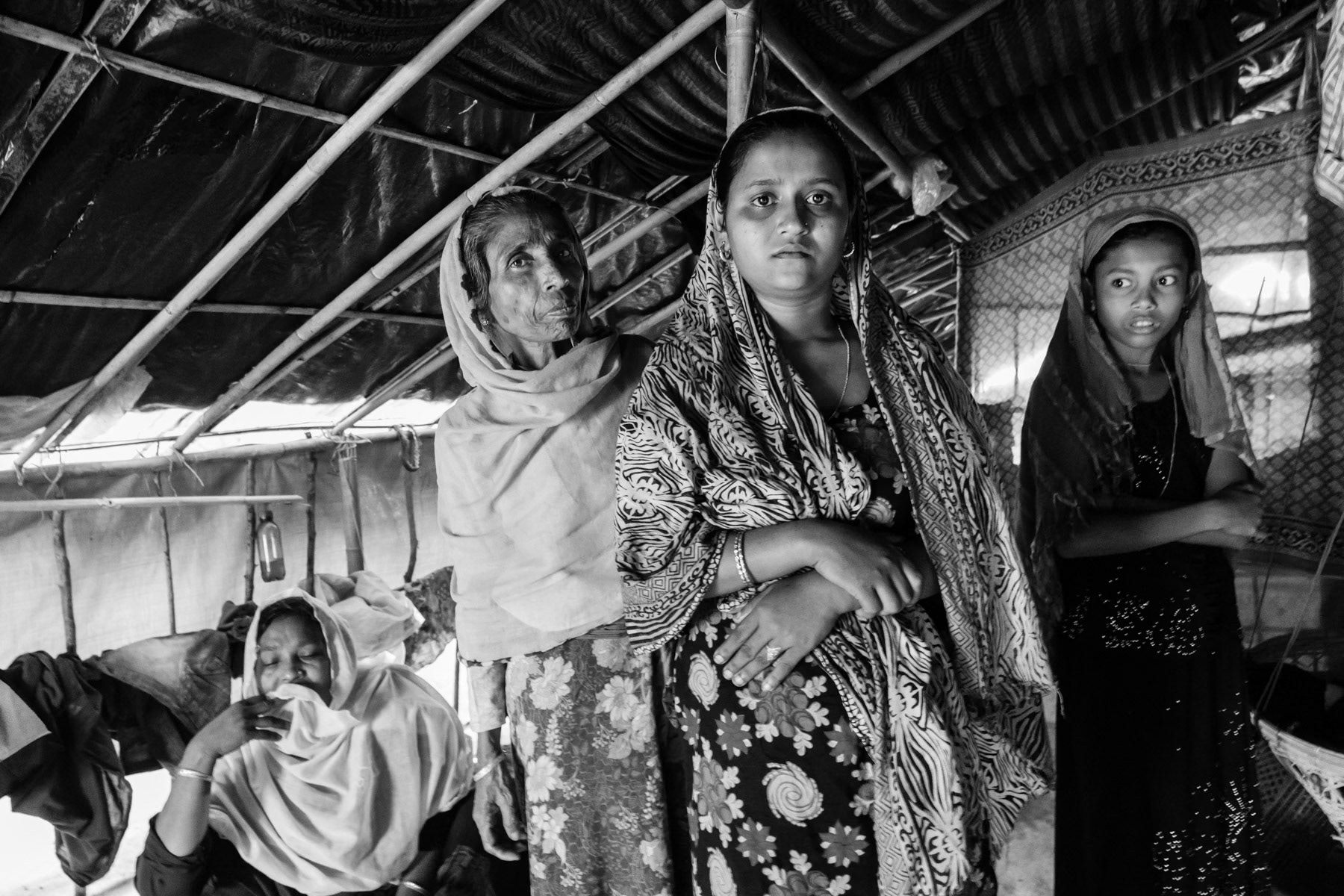
Setera Begum fled from Rathedaung. When their village was attacked end of August, she got shot in the neck. She has 3 sons and a husband and all managed to reach Bangladesh after 14 days of walk through the forests and mountains. She got the first medical attention 15 days after being shot once passing the border. Kutupalong refugee camp in Ukhiya, Bangladesh, November 2017

Mohamed A. is 10 years old and from Rabayla near Maungdaw. He was hit by a shrapnel from a helicopter shell just under the eye. It took him seven days to reach Bangladesh. He witnessed the execution of his parents by the Burmese military. He came and lives with his grandmother. He lost every track of his younger brother since the attack. Kutupalong refugee camp, Bangladesh, November 2017

A Rohingya girl overlooking a new makeshift camps for the newly arrived Rohingya refugees from Myanmar. More than 650,000 refugees have fled persecution in neighbouring Myanmar since August 2017. Lambashiya section of Kutupalong refugee camp, Ukhiya, Bangladesh, November 2017
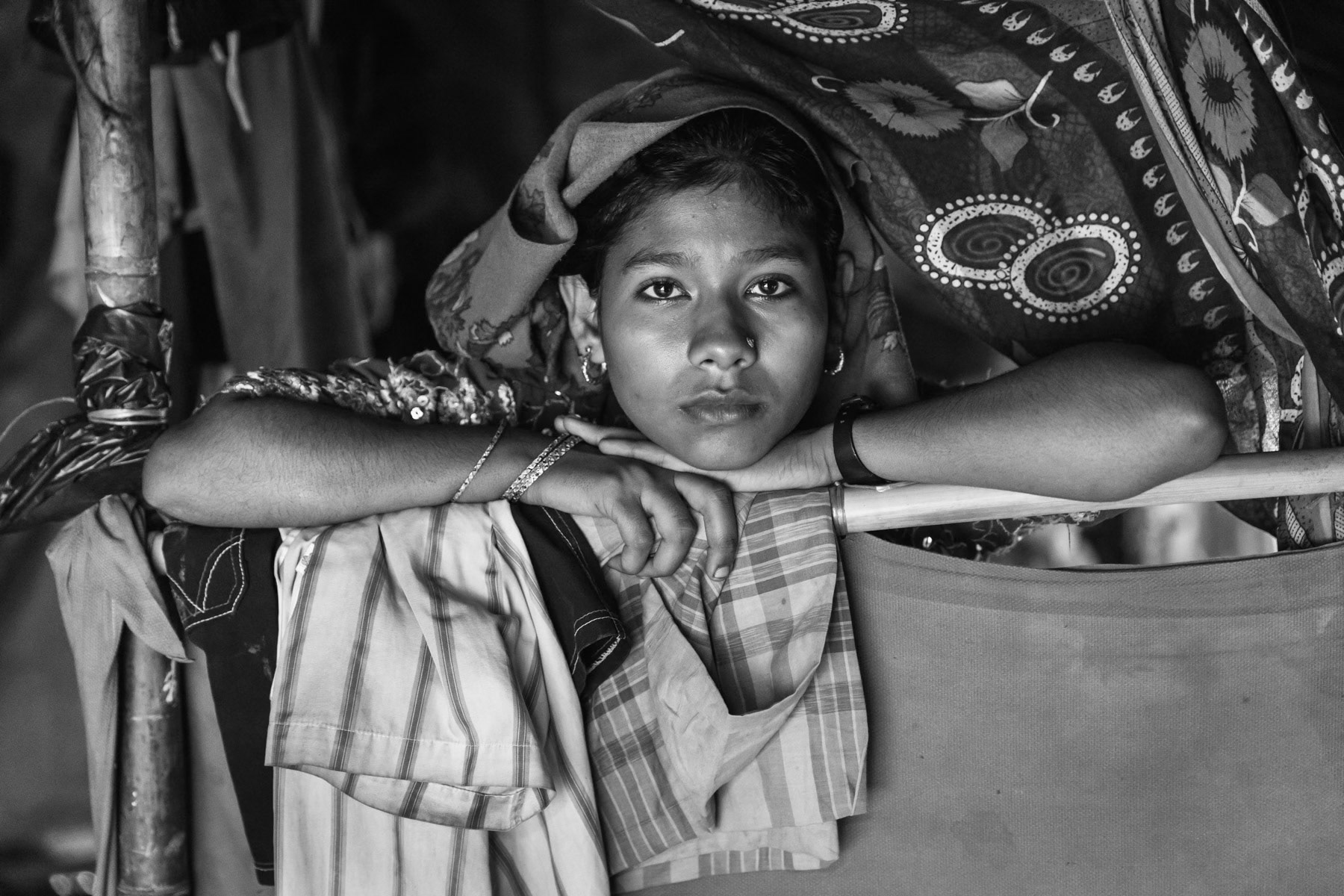
Rohingya refugee from Shilhadi in Rathedaung township. Their village was attacked begining September 2017 by military forces. The village was attacked by at least 100 military forces aided by local Rakhine extremists. The extremists were decapitating people. Eight hundred Rohingya, mainly landowners and agriculturors were living in her village, all fled or were killed and the village was burnt down. It took her 18 days to reach Bangladesh helping her sister who had been shot in the leg. Kutupalong camp, Cox's Bazar, Bangladesh, November 2017
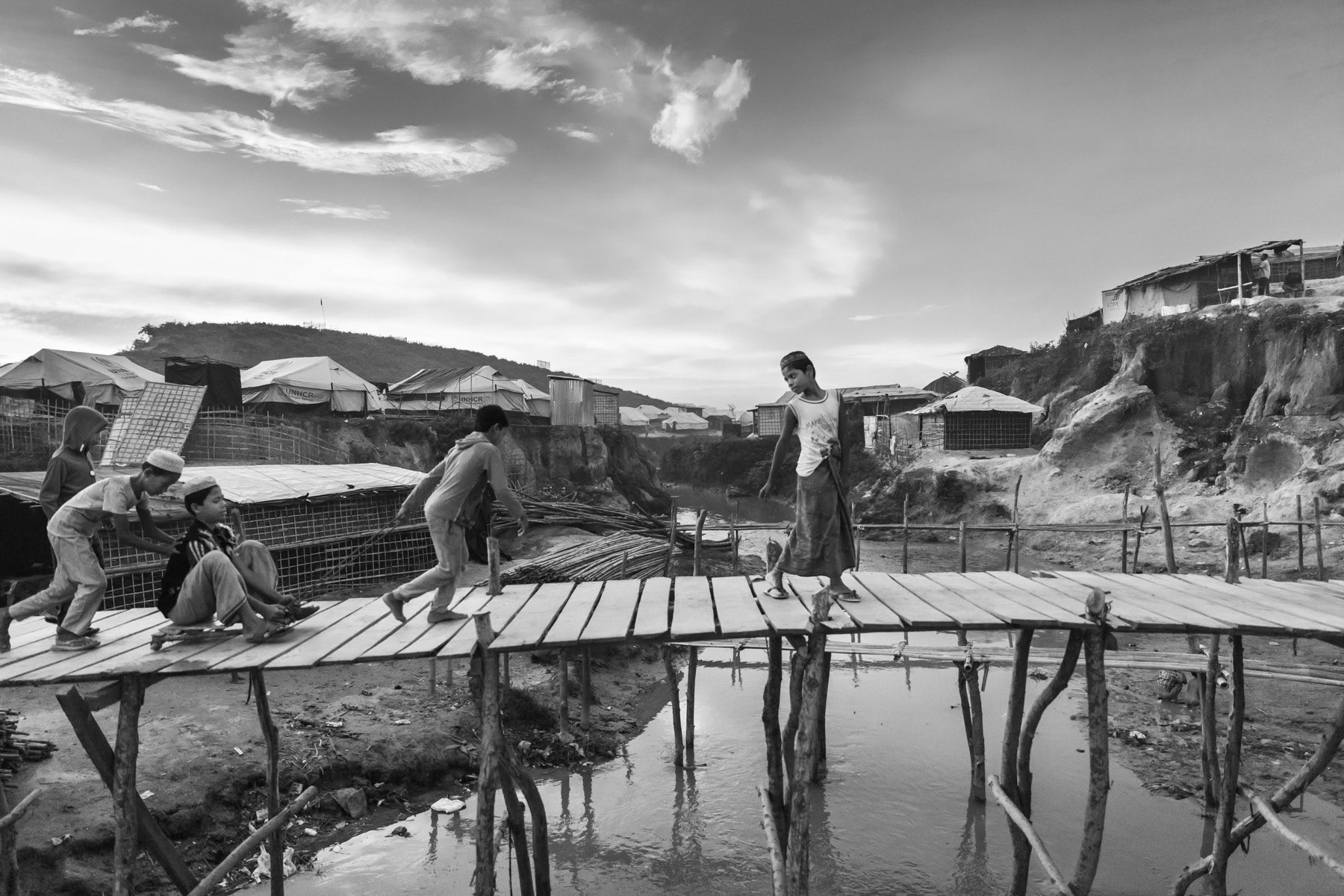
Rohingya children moving around a new section of makeshift shelters for newly arrived refugees from Burma. Kutupalong extension, Ukhiya, Bangladesh, November 2017
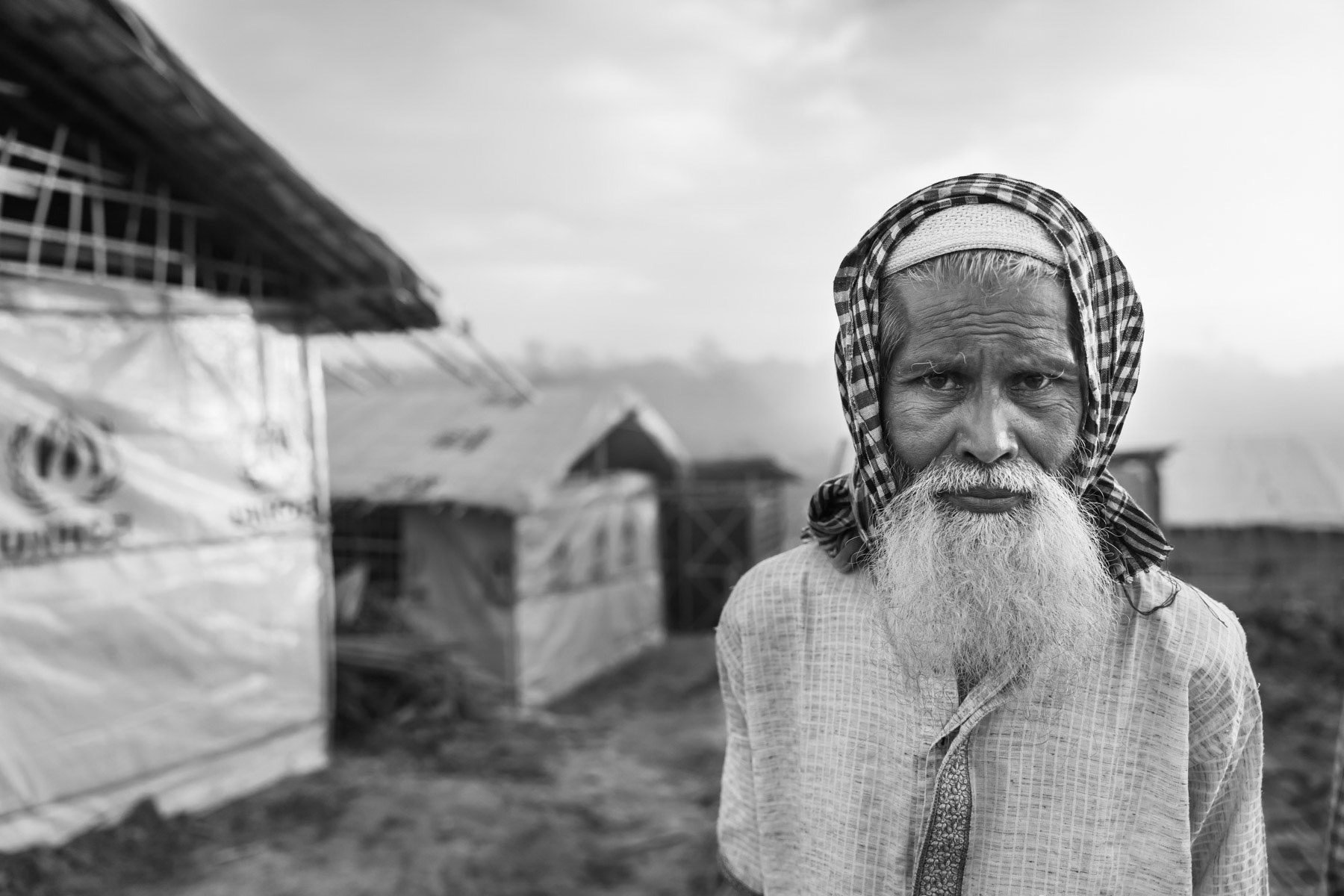
A Rohingya refugee that recently arrived from Myanmar. Rohingya have fled Myanmar since August and the start of the latest military security operations that are now widely qualified as ethnic cleansing campaigns. Kutupalong refugee camp, Ukhiya, Bangladesh, November 2017
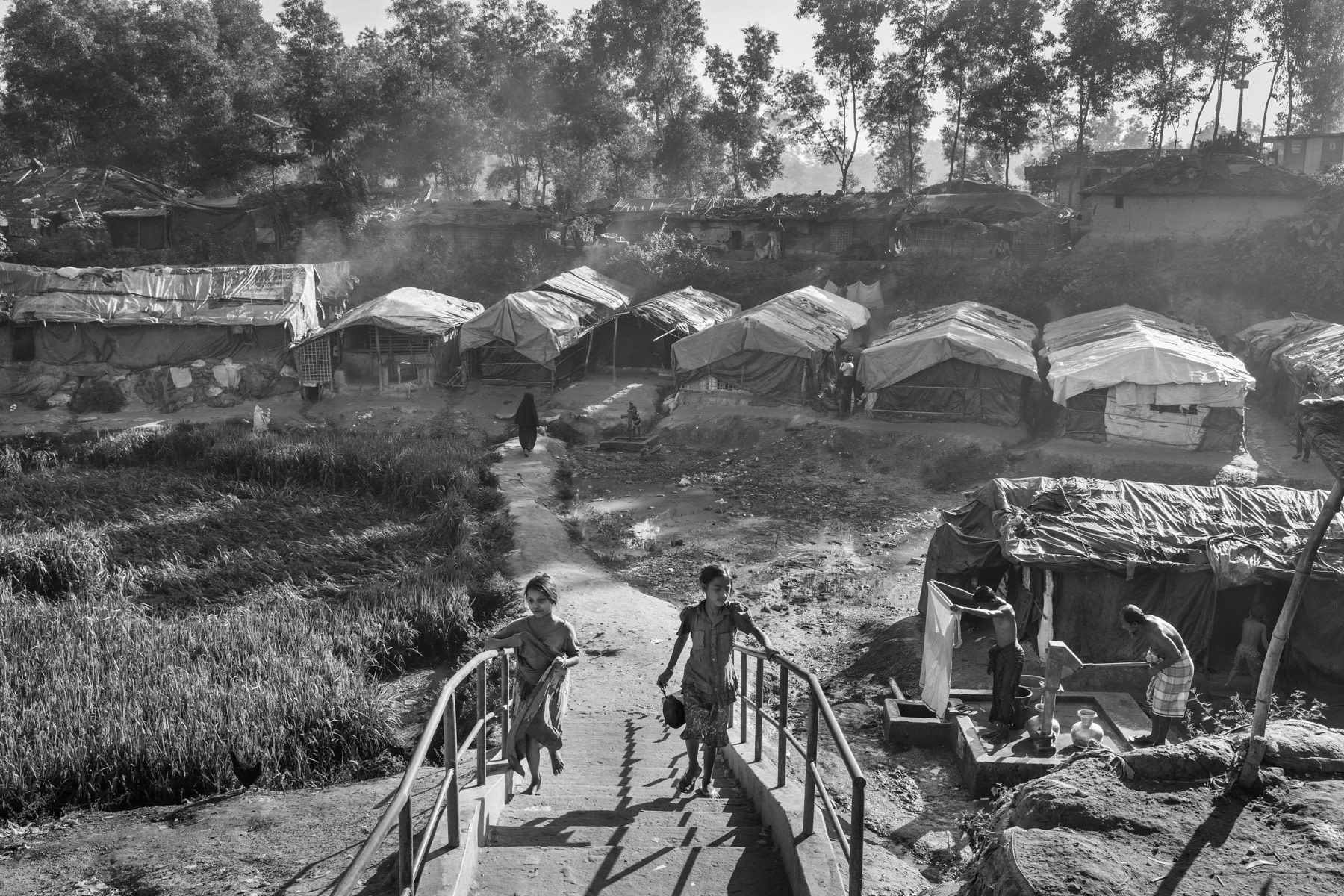
A new extension of the already huge Kutupalong refugee camp to shelter a part of the 650,000 newly arrived Rohingya refugees. Kutupalong camp is now sheltering Rohingya victims of the 1978, 1992, 2008, 2012, 2016 and 2017 ethnic cleansing campaigns. By the end of 2017 nearly one million Rohingya refugees live in Kutupalong, Bangladesh, November 2017

A woman, her niece and six children fled from Maungdaw 3 months ago after her husband was killed when their village was attacked. Lambashiya section of Kutupalong refugee camp, Ukhiya, Bangladesh, November 2017
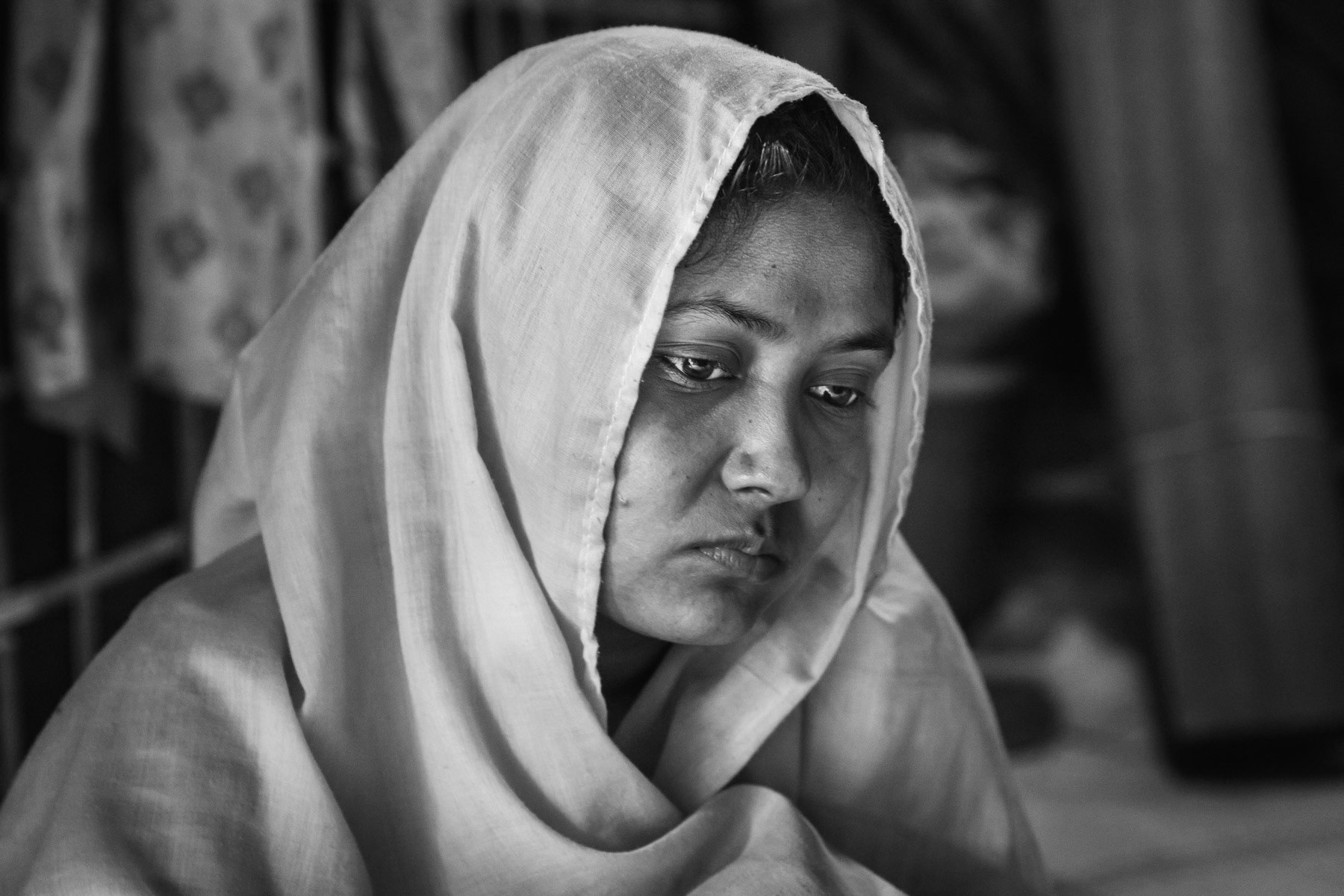
Shopika Begum, 20 years from Tula Tuli in Maungdaw township in Myanmar. She was gang raped by the military forces that attacked the village on 30 August 2017. Shopika's husband was executed and decapitated, she was taken with approximately 30 other women to barracks where they would be repeatedly gang raped by groups of 5-6 military. After the gang rapes the women would be assaulted with machette, left for dead and burned in the barracks. Very few survived, only those that had still the strenght to escape through the back and the fields. It took her 5 days to reach Bangladesh. She was reunited with her sister once in Bangladesh. There have been countless witnesses of atrocities by the Burmese regime and its military forces. Human rights commissions and international groups have called the ongoing onslaught a schoolbook case of ethnic cleansing evoloving into a genocide of the Rohingya community in Rakhine. Widespread gang rapes have been widely documented through testimonies of the survivors in the camps. Balukhali camp for Rohingya refugees in Bangladesh, November 2017
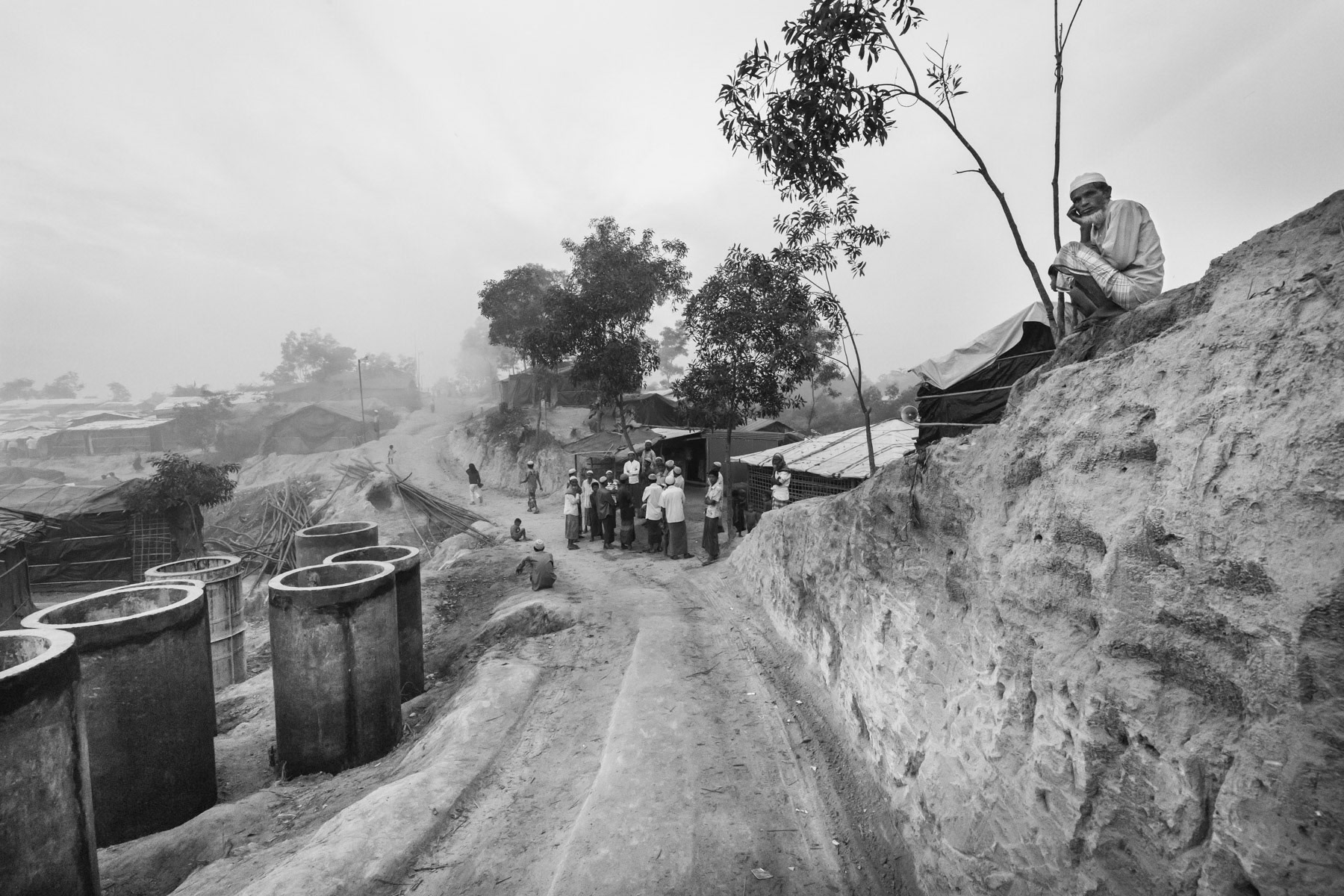
A new extension of the already huge Kutupalong refugee camp to shelter a part of the 650,000 newly arrived Rohingya refugees. Kutupalong camp is now sheltering Rohingya victims of the 1978, 1992, 2008, 2012, 2016 and 2017 ethnic cleansing campaigns. By the end of 2017 nearly one million Rohingya refugees live in Kutupalong, Bangladesh, November 2017
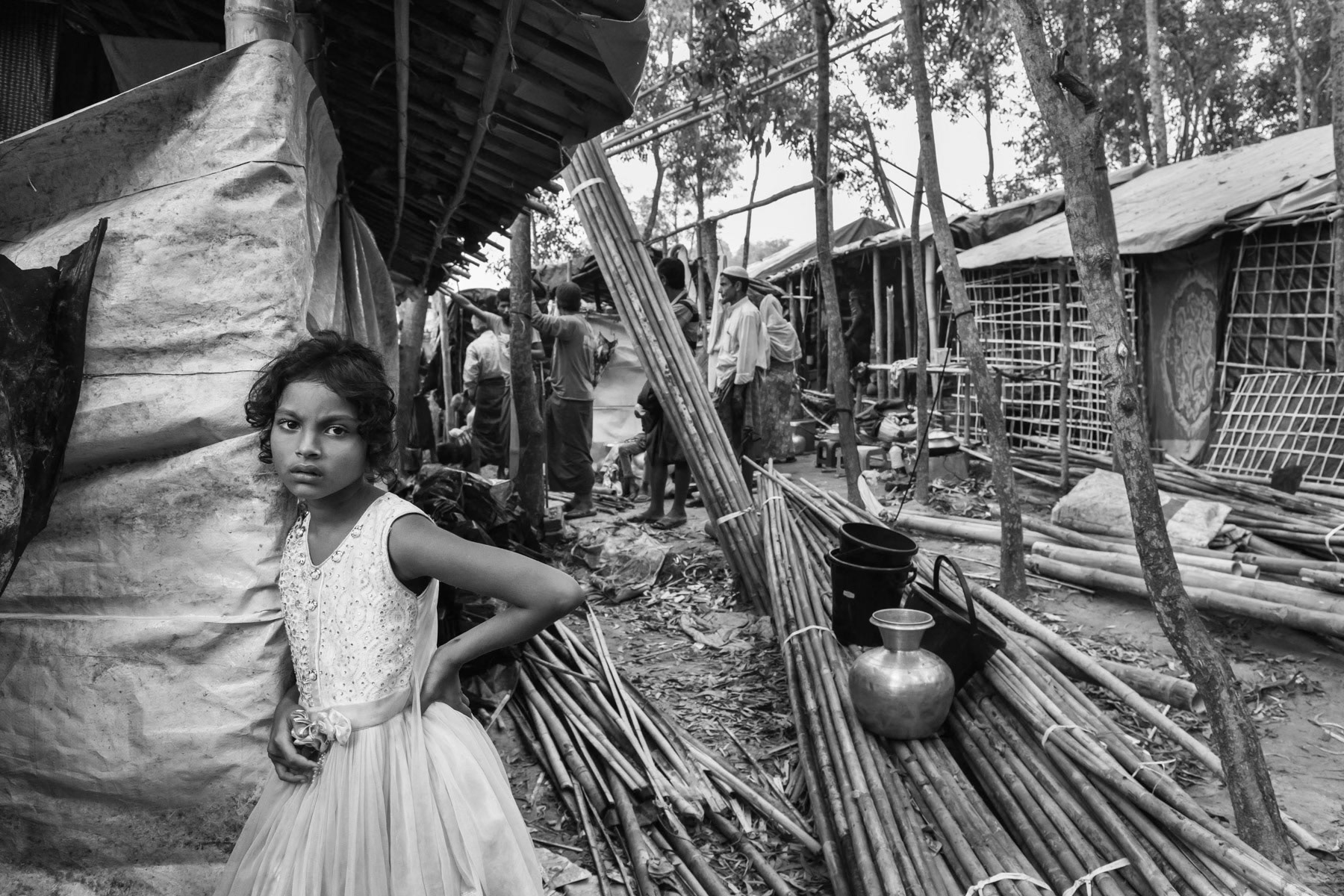
A Rohingya girl and her family that arrived few days earlier building their makeshift shelter with donated materials. The huge influx of refugees during the past months has put an enourmeous strain on the local environment and economy resulting in substantial deforestation, price hikes and tensions with the local community. Lambashiya section of Kutupalong refugee camp, Ukhiya, Bangladesh, November 2017
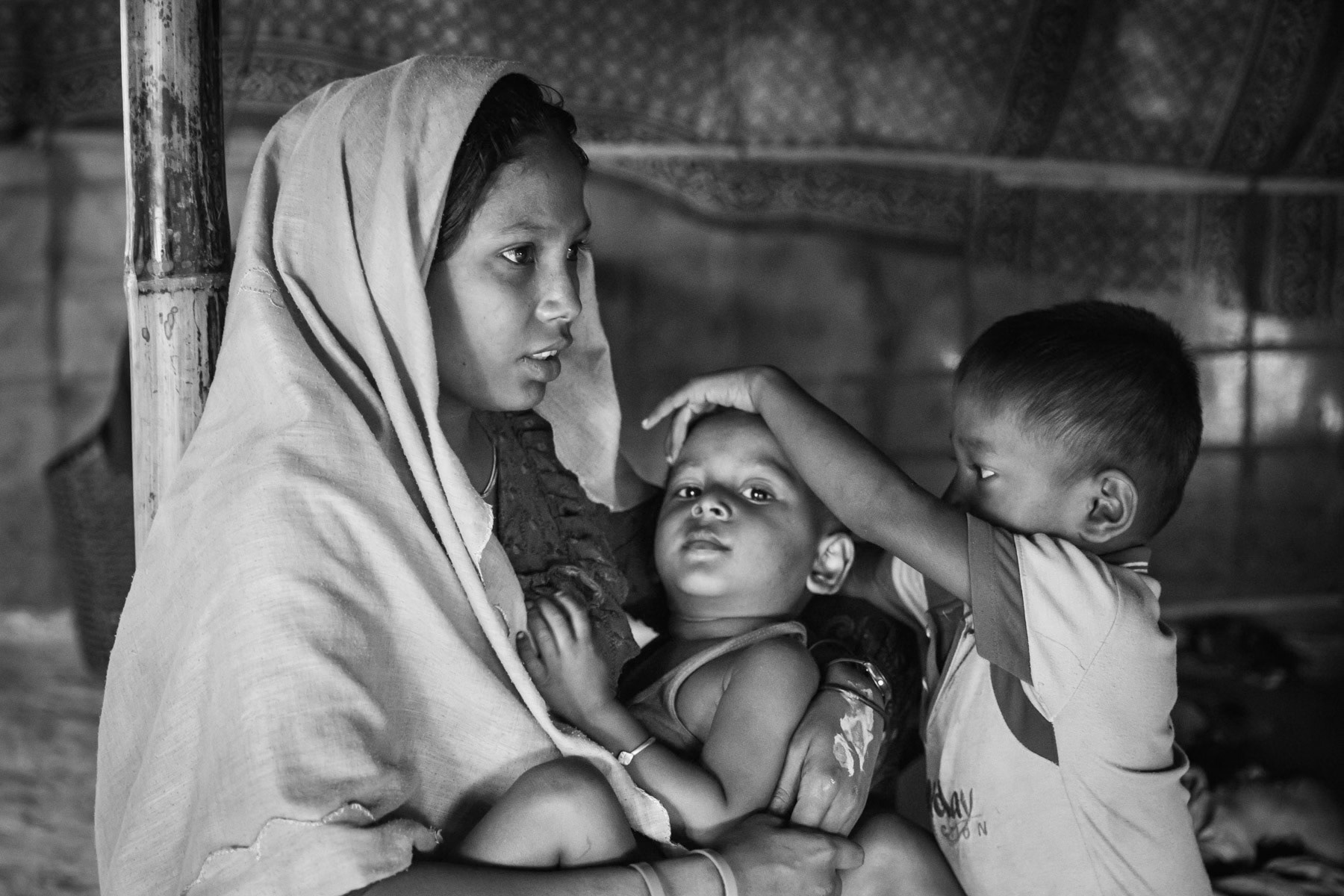
Rehana Begum from Rathedaung in Myanmar is 25 years old and has 3 sons, the youngest being 1 month old only. She fled to Bangladesh with her mother, grandmother and children nearly 3 months ago. She was gang raped by the Myanmar military for 5 days while she was pregnant. Her husband was killed, decapitated and burnt in front of them when the village was attacked and entirely burnt down in August 2017. Lambashiya section of Kutupalong camp in Ukhiya, Bangladesh, November 2017

New makeshift blocks for the newly arrived Rohingya refugees from Myanmar. More than 650,000 refugees have fled persecution in neighbouring Myanmar since August 2017. Balukhali refugee camp, Ukhiya, Bangladesh, November 2017

Religious class for Rohingya children that have recently fled from Myanmar, Kutupalong camp near Cox's Bazar, Bangladesh, November 2017
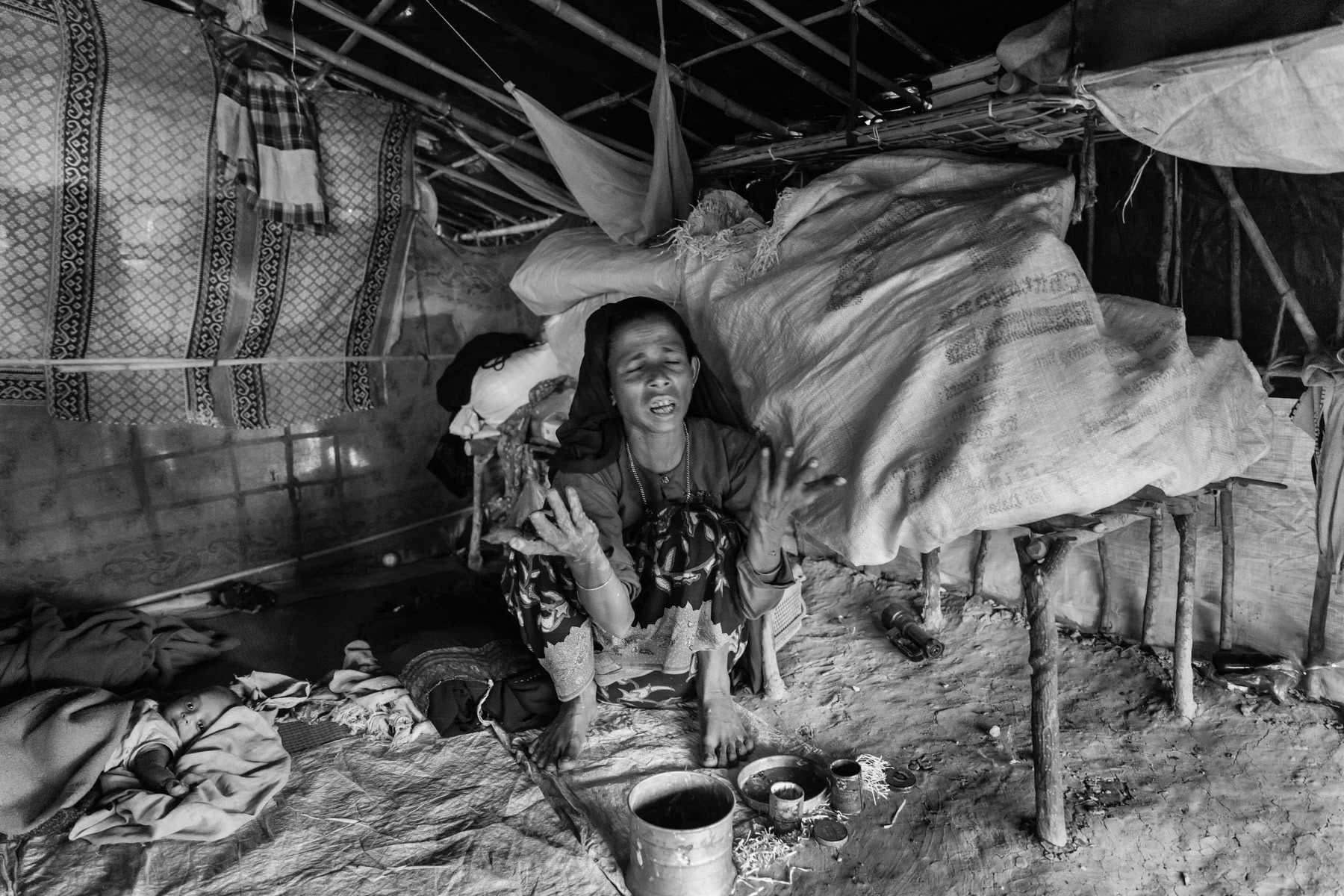
Rehana Begum's forty years old mother. She fled to Bangladesh from Rathedaung in Myanmar with her daughter and mother, and grand children nearly 3 months ago. Her daughter was gang raped by the Myanmar military for 5 days while she was pregnant. Her son in law was killed, decapitated and burnt in front of them when the village was attacked and entirely burnt down in August 2017. Lambashiya section of Kutupalong camp in Ukhiya, Bangladesh, November 2017

New makeshift blocks for the newly arrived Rohingya refugees from Myanmar. More than 650,000 refugees have fled persecution in neighbouring Myanmar since August 2017. Balukhali refugee camp, Ukhiya, Bangladesh, November 2017
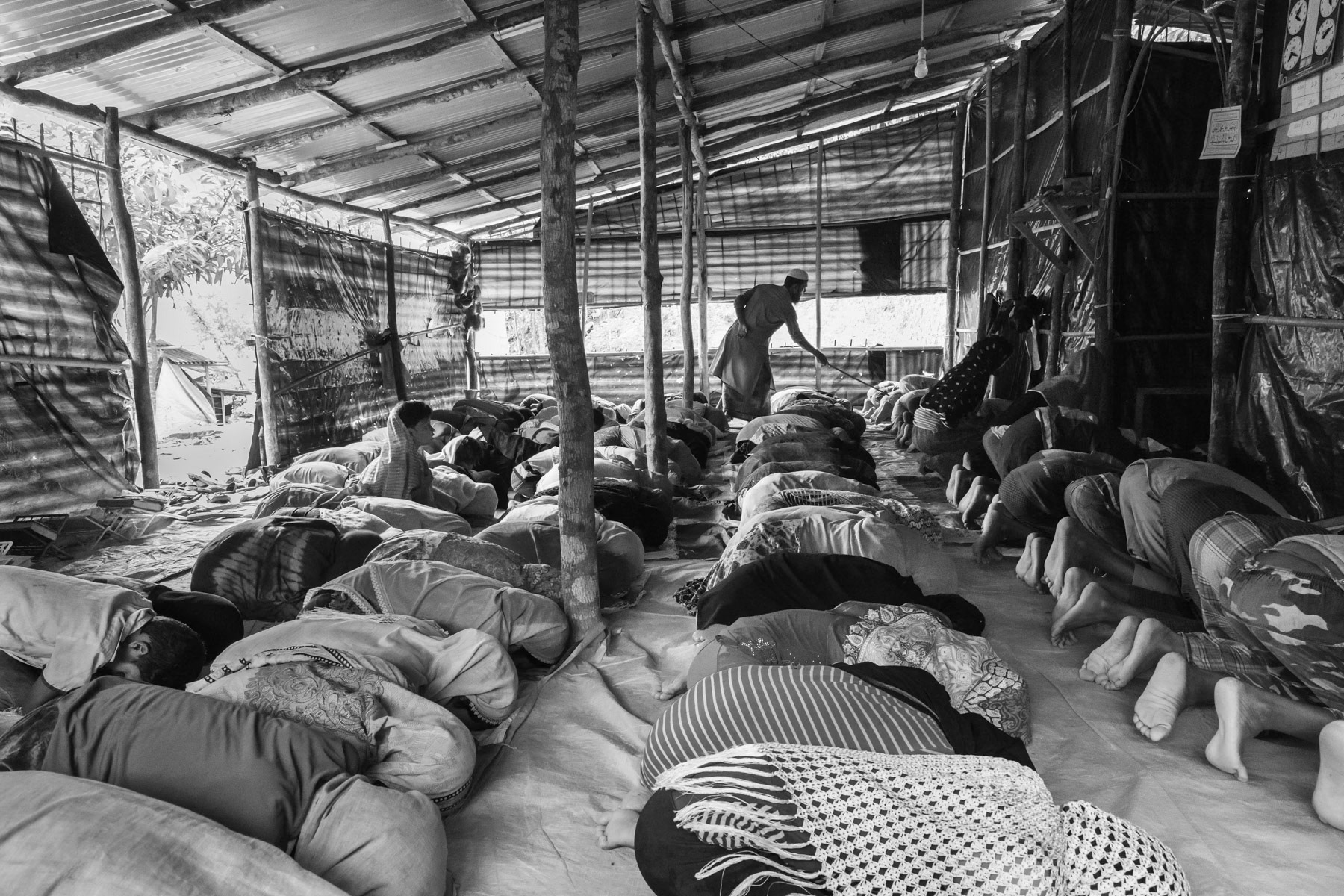
Religious class for Rohingya children that have recently fled from Myanmar, Kutupalong camp near Cox's Bazar, Bangladesh, November 2017

New makeshift blocks for the newly arrived Rohingya refugees from Myanmar. More than 650,000 refugees have fled persecution in neighbouring Myanmar since August 2017. Lambashiya section of Kutupalong refugee camp, Ukhiya, Bangladesh, November 2017

Mohamed Jubair, 33 years old from Maungdaw township. Has spend 7 years in jail in Mandalay accused of terrorism. His brother was an imam and was killed in October 2016 during the first military security operations in Maungdaw. He was released from jail 3 months before his village got attacked again in September 2017. He managed to escape with his wife and 2 sons but was shot while carrying his 3 year old son who died instantly. Despite being shot and having lost his young son he managed to bring the rest of his family to safety in Bangladesh where he also got medical treatment. It took them 3 days to reach Bangladesh. Balukhali refugee camp, Ukhiya, November 2017
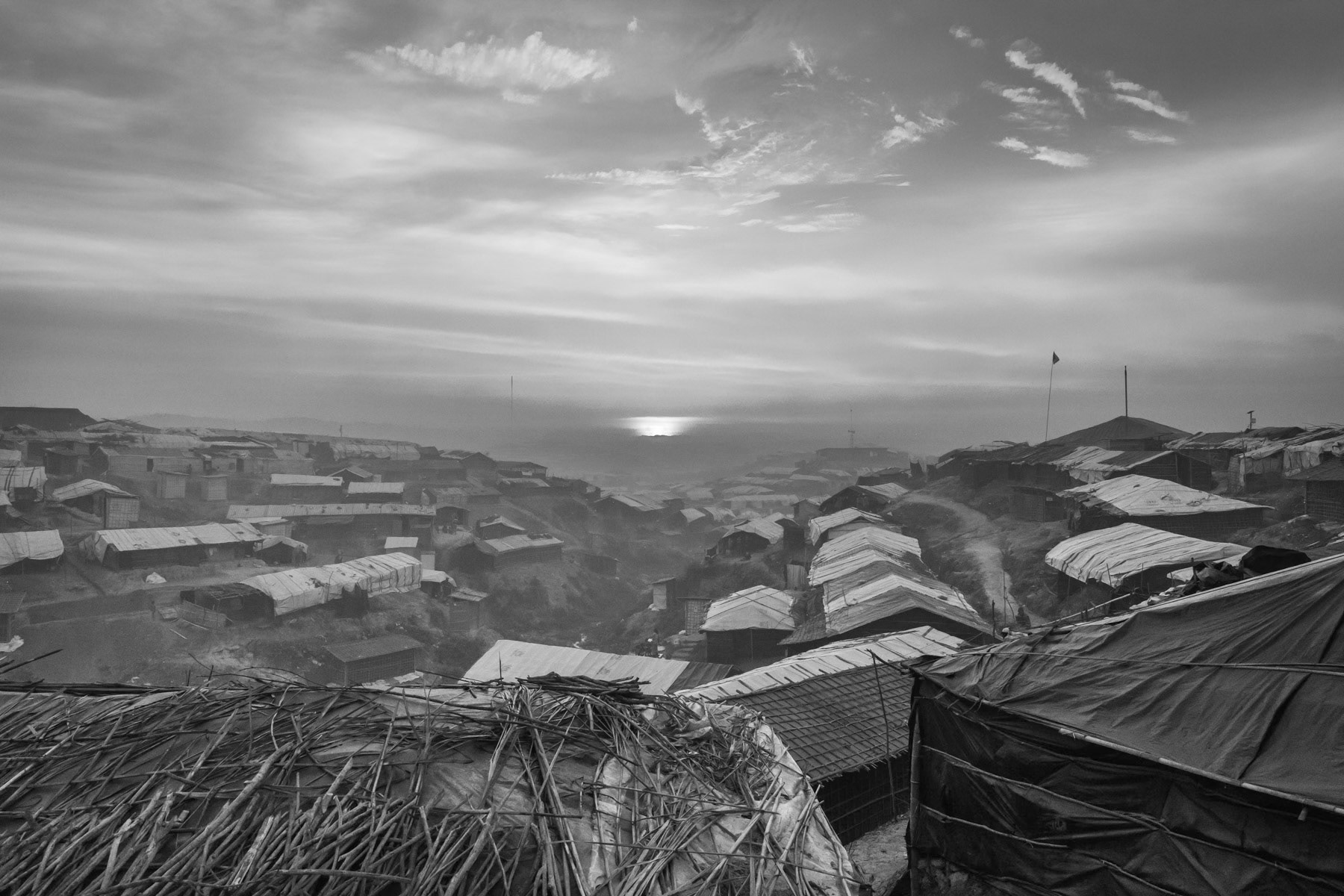
A new extension of the already huge Kutupalong refugee camp to shelter a part of the 650,000 newly arrived Rohingya refugees. Kutupalong camp is now sheltering Rohingya victims of the 1978, 1992, 2008, 2012, 2016 and 2017 ethnic cleansing campaigns. By the end of 2017 nearly one million Rohingya refugees live in Kutupalong, Bangladesh, November 2017

Fatima Khatun, 20 years old from Shilhadi in Rathedaung township. She has one daughter and one son, her husband was arrested by the military and jailed 8 months ago. Their village was attacked begining September 2017 by military forces. During the attack her sister in law and her two children were executed and decapitated in front of her. She managed to escape but was shot in the leg. Her mother had left the village before the attack with her 2 children. The village was attacked by at least 100 military forces aided by local Rakhine extremists. The extremists were decapitating people. Eight hundred Rohingya were living in her village, all fled or were killed and the village was burnt down. It took her 18 days to reach Bangladesh helped by her sister and her brother in law. She got the first medical care after having reached Bangladesh and still faces difficulties to walk. She has been without news from her husband for the past 6 months. Kutupalong camp, Cox's Bazar, Bangladesh, November 2017
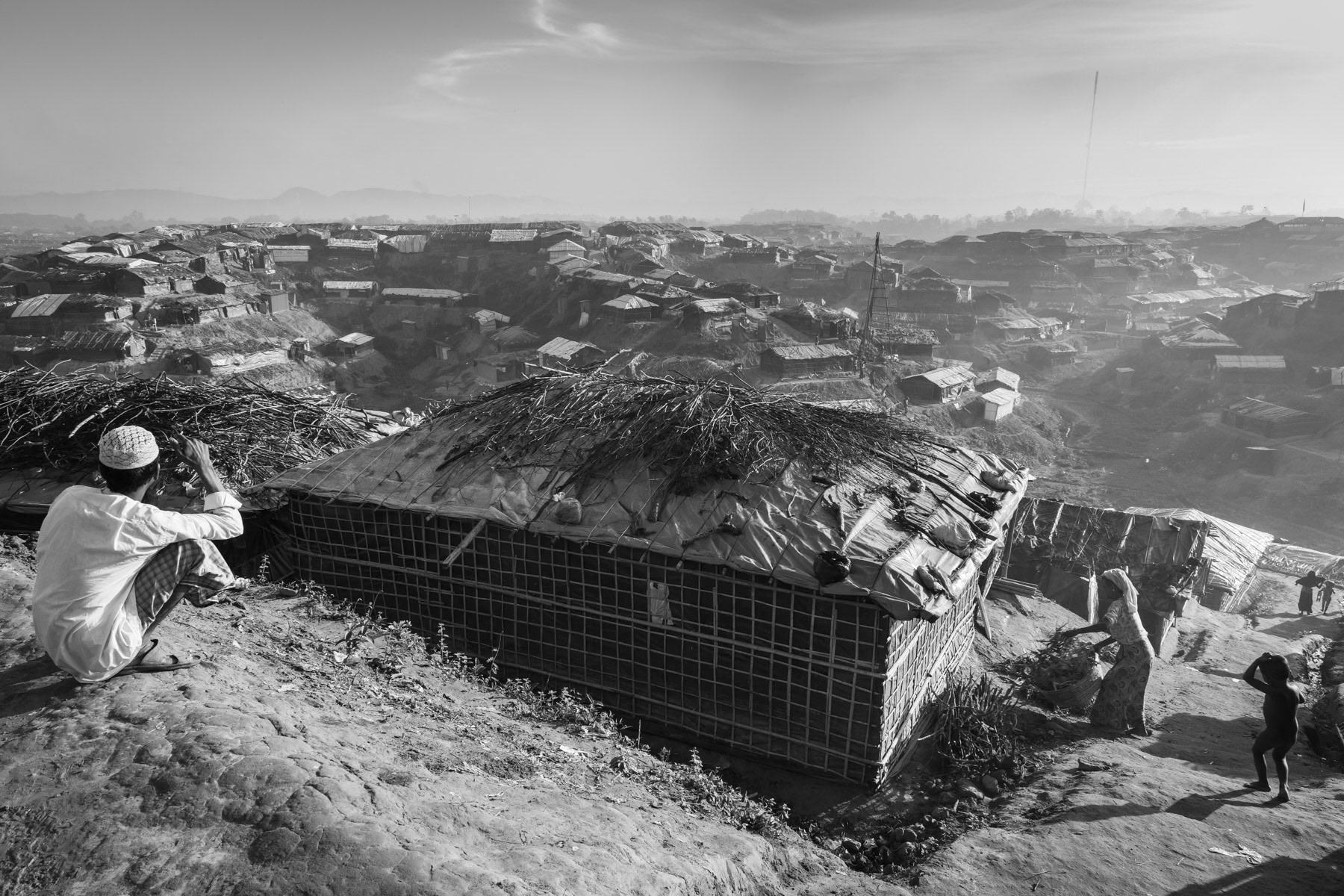
New makeshift blocks for the newly arrived Rohingya refugees from Myanmar. More than 650,000 refugees have fled persecution in neighbouring Myanmar since August 2017. Kutupalong refugee camp, Ukhiya, Bangladesh, November 2017
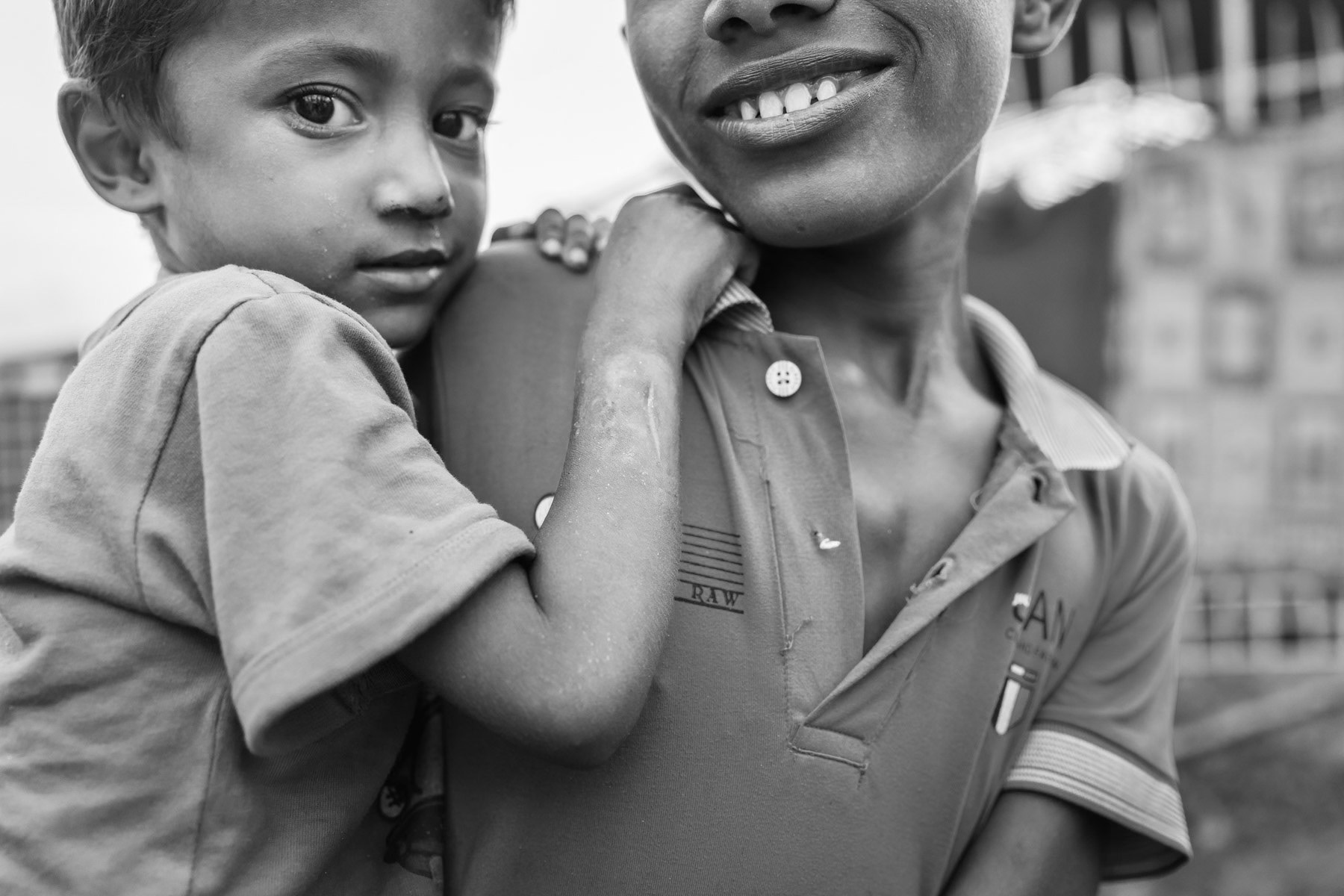
Mohamed Ziarad and his 3 year old brother were hit by helicopter fire while their village near Buthidaung in Myanmar was attacked. After several days walk through the jungle they found refuge in Bangladesh as the more than 650,000 Rohingya refugees that have fled Myanmar since August 2017. Lambashiya section of Kutupalong refugee camp, Ukhiya, Bangladesh, November 2017
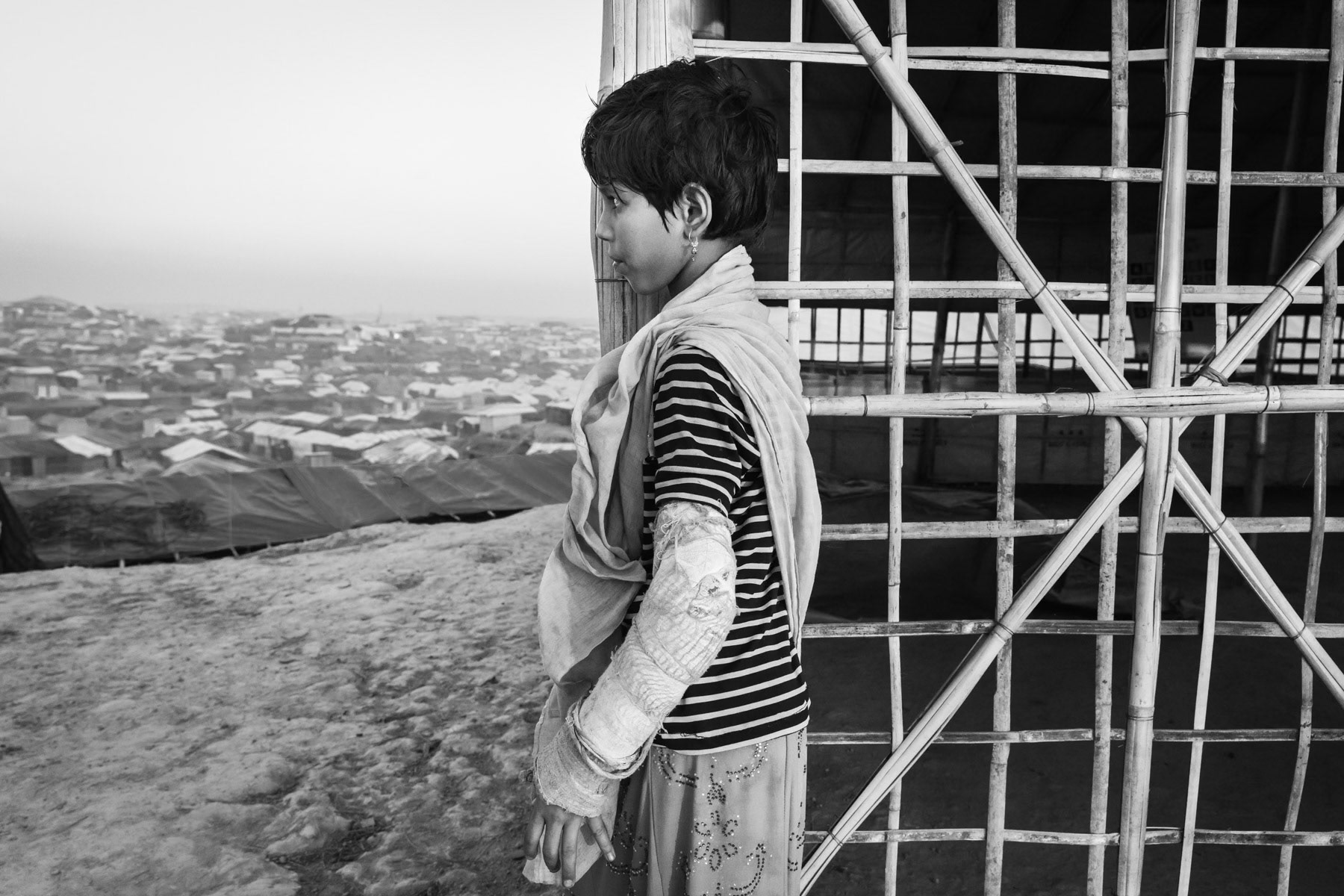
Azida , eight years old from Boli Bazar in Maungdaw township. Her father was shot and killed when the village was attacked. She has five sisters and brothers, two other brothers were killed during the attack. While fleeing and crossing the border she fell and broke her arm. She has been for 10 weeks in Bangladesh with her remaining family. Kutupalong refugee camp, Bangladesh, November 2017
